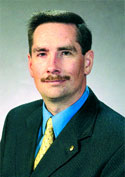
Features
Codes and standards
Hot topics
NFPA Impact: An update on standards for fire fighting apparatus
An update on standards for fire fighting apparatus
December 7, 2007
By Sean Tracey
 In 2002, I presented a very quick primer on fire fighting apparatus standards. As a number of these standards have changed since that date, it is worthwhile we consider an update on these. Several of these are new editions and others are currently in the review process. Also, since the release of Underwriters Laboratory Canada's ULC-S515 standard in 2004 there is more referencing back to NFPA 1901.
In 2002, I presented a very quick primer on fire fighting apparatus standards. As a number of these standards have changed since that date, it is worthwhile we consider an update on these. Several of these are new editions and others are currently in the review process. Also, since the release of Underwriters Laboratory Canada's ULC-S515 standard in 2004 there is more referencing back to NFPA 1901.
The standards of primary interest regarding fire apparatus remain:
· NFPA 414 – Standard for Aircraft Rescue and Fire Fighting
Vehicles 2007 Edition – Brand new for October 2006.
· NFPA 1901- Standard for Automotive Fire Apparatus 2003 Edition – The standard has incorporated major changes based upon fire service recommendations and improvements to consider our increasing awareness of fire fighter safety issues.
· NFPA 1906 – Standard for Wildland Fire Apparatus 2006 Edition – This covers new wildland fire apparatus that will be used for suppression. It has been updated with annexes on size and weight charts, baffling systems and an annex similar to NFPA 1901 with guidance on when wildland fire apparatus should be considered front or second line.
Remember all NFPA standards are now available for free viewing through a visit to the organization's website at www.nfpa.org.
Retirement age for fire apparatus
Often NFPA is asked what specific guidance is available about mandatory retirement ages for fire apparatus. Although the standard does not specify a mandatory retirement age, as fire apparatus can be retained in service if it continues to meet performance requirements, Annex D of NFPA 1901 and now in NFPA 1906 gives guidance on when fire apparatus should be placed in reserve status. It states: "Because the changes, upgrades, and fine tuning to NFPA 1901 since 1991 have been truly significant, especially in the area of safety, fire departments should seriously consider the value (or risk) to fire fighters by keeping pre-1991 edition of NFPA 1901 fire apparatus in first-line service."
The annex provides more detailed information on the rationale and the various safety factors incorporated. So essentially, if your fire apparatus was not constructed to these standards, then there is reduced safety for your fire service members. A risk benefit analysis should be undertaken and a replacement schedule identified.
Now what does this mean regarding fire apparatus specified to the ULC standard? As the ULC S-515 Edition was first produced in 1988, it would therefore not include the safety features incorporated in the NFPA 1901 1991 edition. Only subsequent amendments would have addressed these. Vehicle manufacturers would, however, have considered many of these improvements regardless of what was specified in the ULC standard. So any apparatus specified to the ULC standard should be compared to the safety components introduced in the NFPA edition starting in 1991 and retirement considerations based on this.
Fire Underwriters Survey (FUS) accepts NFPA 1901 as equivalent.
I am also often asked whether departments need to specify to the ULC or NFPA standard. In a recent move, FUS has confirmed that they will accept NFPA specified apparatus as equivalent in determining their ratings.
This means buyers now have an opportunity to specify to either standard. Buyers are still advised that there are three minimum requirements that buyers specifying to NFPA 1901 need to follow to be acceptable to FUS. These include a minimum tip load of 500 pounds for aerial devices, an increased hosebed capacity, and an automatic emergency shutdown. It is also important to note that apparatus complying with NFPA 1901 must be certified by an accredited third party. Manufacturers providing this service option can advise on the certification process they shall be following.
Sean Tracey, P.Eng., is the Canadian regional manager of NFPA
International and formerly the Canadian Armed Forces Fire Marshal. He
may be reached at 613-830-9102, e-mail stracey@nfpa.org .
Print this page